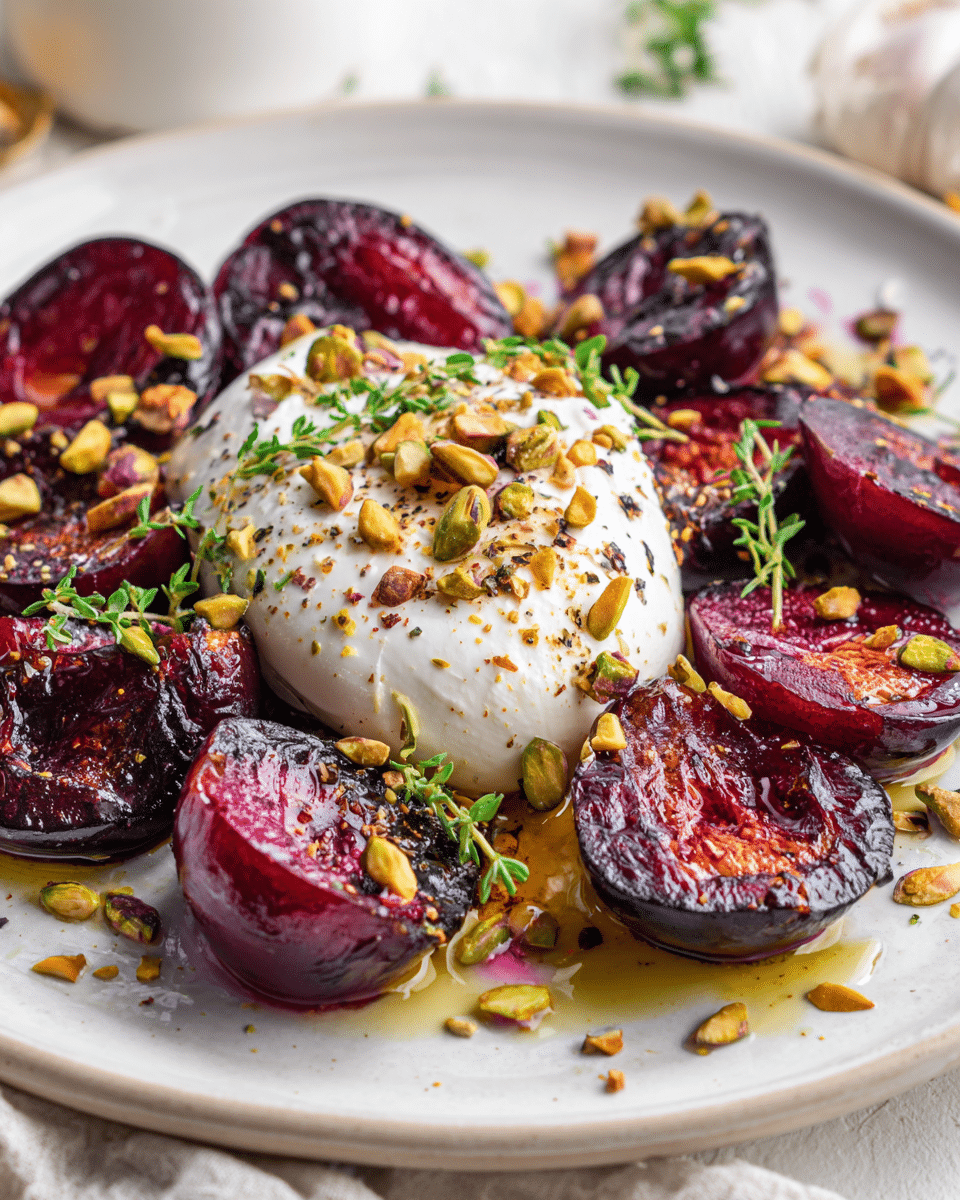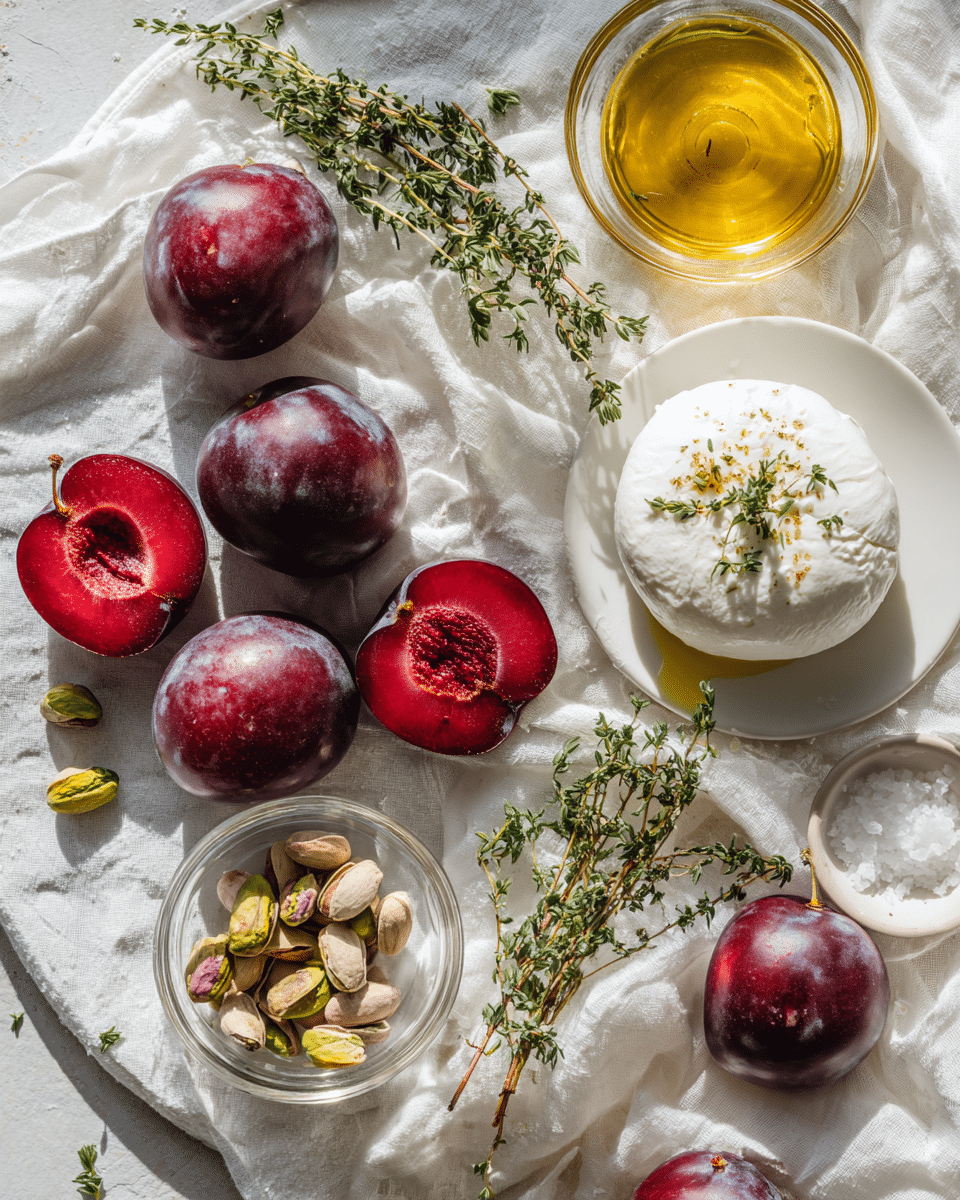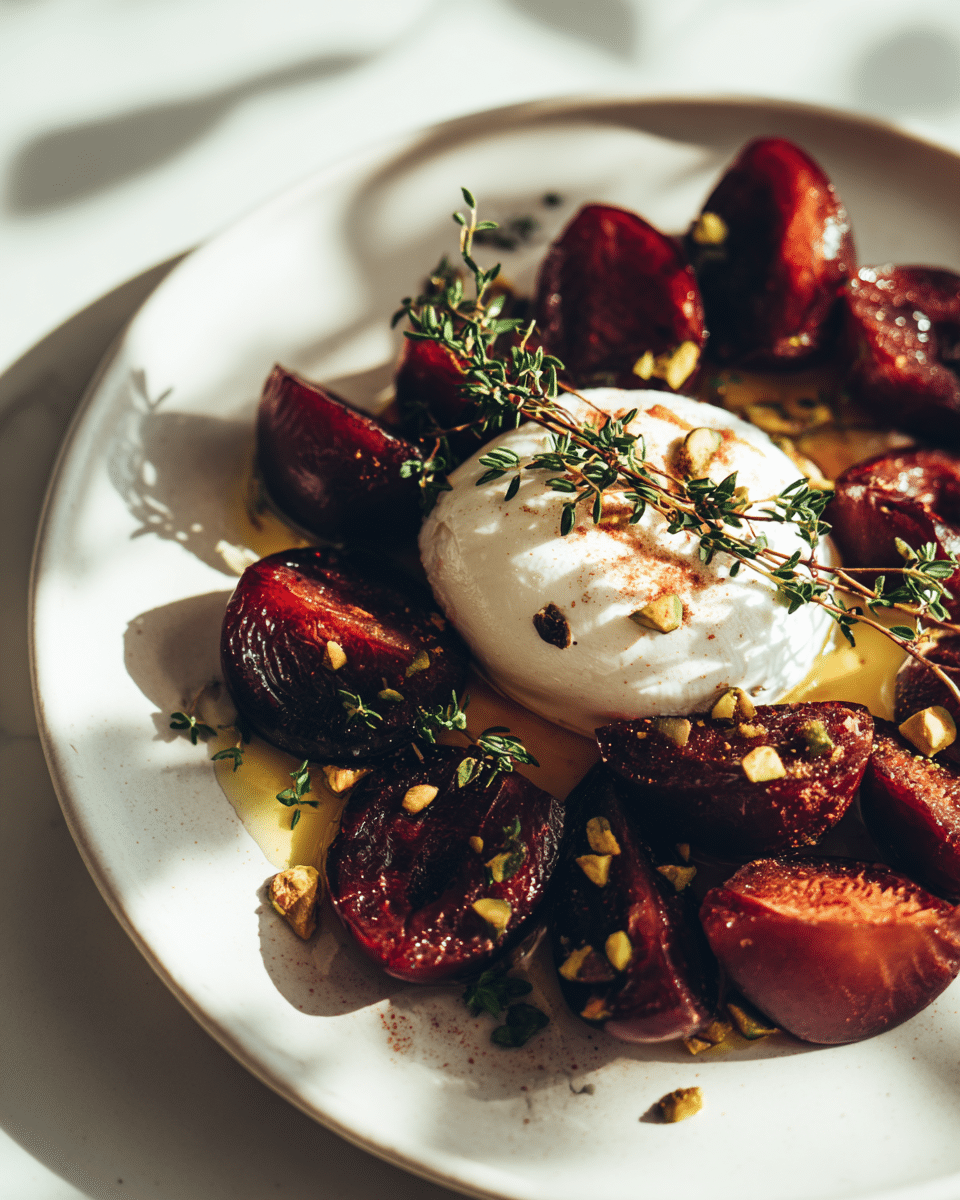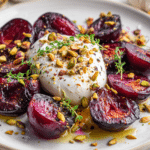

Table of Contents
Burrata with Roasted Plums. Crunchy pistachios. Fresh thyme. This isn’t just another cheese platter—it’s a sweet-savory masterpiece that blends creamy richness, fruity intensity, and a touch of herbal freshness into one unforgettable dish.
In this article, you’ll discover why Burrata with Roasted Plums, Pistachios & Thyme is the perfect summer appetizer, how to make it step-by-step, and answers to burning questions like “Can you roast burrata?” and “What fruit pairs best with it?”
Looking for inspiration? Try our other elevated burrata pairings like grilled peach burrata salad or roasted cherry burrata bites. Discover more delicious ideas
Why This Burrata with Roasted Plums Recipe Is a Must-Try
What Makes Burrata So Special in Recipes?
Burrata is a rich Italian cheese made from mozzarella and cream. While it looks like a ball of fresh mozzarella from the outside, the inside is a luxurious blend of stracciatella and thick cream that oozes out when sliced.
Its mild, milky flavor and soft texture make it the ideal canvas for sweet or savory additions. That’s exactly why roasted plums and burrata are such a dreamy match—fruity caramelized flavor meets silky cheese in the most delightful way.
The Perfect Marriage: Sweet Roasted Plums and Creamy Burrata
Roasted plums intensify in flavor and sweetness as they caramelize in the oven. Their natural juices create a syrupy glaze, especially when baked with a drizzle of honey or olive oil.
Pair them with chilled burrata and you’ve got an exciting contrast of warm and cold, soft and crisp, tangy and creamy. Every bite delivers flavor and texture you can’t resist.
Check out another flavor-packed combo: Whipped Ricotta
A Touch of Crunch and Freshness: Pistachios & Thyme
To elevate the dish further, sprinkle chopped pistachios for crunch and nutty depth. Their subtle sweetness complements both the cheese and fruit.
Fresh thyme adds an earthy, citrusy note that cuts through the richness and enhances the aroma. This final touch makes the dish feel fresh, bright, and restaurant-worthy.
Whether you’re serving this for brunch, a date night, or a fancy dinner party, Burrata with Roasted Plums, Pistachios & Thyme is a dish that delivers flavor and elegance with zero stress.
Ingredients and Step-by-Step Preparation
What You’ll Need: Ingredient List & Kitchen Tools
This dish comes together with just a few quality ingredients. Here’s what to gather:
Ingredients
| Ingredient | Quantity | Notes |
|---|---|---|
| Burrata cheese | 1 large ball (or 2 small) | fresh and chilled |
| Ripe plums | 4–5 | halved and pitted |
| Pistachios | ¼ cup | chopped, unsalted preferred |
| Fresh thyme | 2–3 sprigs | leaves only |
| Olive oil | 2 tbsp | extra virgin for best flavor |
| Honey | 1 tbsp | optional, for added sweetness |
| Sea salt | pinch | to finish |
| Cracked black pepper | to taste | optional |
Tip: Choose plums that are slightly soft to the touch. They roast better and deliver more juice.
Kitchen Tools
- Baking sheet or roasting dish
- Parchment paper (optional)
- Mixing bowl
- Serving plate
- Sharp knife
- Spoon for drizzling
Roasting the Plums for Maximum Flavor
The key to this recipe is perfectly roasted plums. Here’s how to get them right:
- Preheat your oven to 400°F (200°C).
- Place the halved plums cut-side up on a lined baking tray.
- Drizzle with olive oil and a bit of honey (if using).
- Roast for 20–25 minutes until they caramelize and start to wrinkle. The juice will bubble and create a sweet glaze.
- Remove from oven and let cool slightly.
Roasted plums should be tender but not falling apart. The goal is juicy, syrupy fruit with structure.


Assembling the Plate: Layering Burrata, Fruit, and Garnishes
Once the plums are roasted, assembling your dish takes just a minute.
- Place the burrata ball in the center of your serving plate.
- Gently spoon the warm roasted plums around it. Let the juices flow onto the plate.
- Sprinkle chopped pistachios over the top for crunch.
- Add fresh thyme leaves for aroma and a pop of green.
- Finish with a drizzle of olive oil and a pinch of sea salt.
Want to serve it warm? Let the plums cool slightly but keep the burrata cold for that irresistible hot-meets-cold sensation.
This dish is best served immediately with toasted sourdough or crackers.
Flavor Pairings & Serving Ideas for Burrata with Roasted Plums
What Fruits Pair Well with Burrata?
While roasted plums are a stunning match for burrata, they’re far from the only fruit that plays nicely with this creamy cheese. Burrata’s mild, buttery flavor pairs exceptionally well with both fresh and roasted fruits that bring acidity, sweetness, or a bit of tartness to the table.
Best Fruit Pairings for Burrata:
| Fruit | Best Served | Flavor Match |
|---|---|---|
| Figs | Fresh or Roasted | Earthy, rich, sweet |
| Peaches | Grilled | Juicy, bright, caramelized |
| Cherries | Roasted or raw | Sweet-tart, vibrant |
| Strawberries | Macerated with balsamic | Tangy and bold |
| Apples or Pears | Fresh, thin-sliced | Crisp, clean contrast |
| Plums | Roasted | Deep, jammy, acidic-sweet |
Each of these can be swapped into your burrata platter depending on the season.
Bread, Crackers, and Wine: What Is Burrata with Roasted Plums Best Served With?
You don’t need to overcomplicate burrata. With a few smart additions, it becomes the centerpiece of a sophisticated spread.
Best Bases to Serve Burrata On:
- Toasted sourdough slices – crispy, tangy, and sturdy
- Grilled flatbread or naan – slightly charred for smoky contrast
- Artisan crackers – especially whole grain or seeded
- Croissants or brioche – for a sweet brunch twist
If you’re going beyond bread, consider layering burrata over a light salad of arugula, radicchio, or spinach tossed in olive oil and lemon. It also pairs beautifully with cured meats like prosciutto or speck.
Wine Pairings That Complement Burrata with Roasted Plums
The creamy texture of burrata calls for wines with good acidity to cut through the richness and balance the fruit.
| Wine | Pairing Notes |
|---|---|
| Prosecco | Light, bubbly, fresh acidity |
| Sauvignon Blanc | Citrus-driven, clean and herbal |
| Rosé | Dry, berry-forward, refreshing |
| Pinot Noir | Soft tannins, cherry-like notes for red lovers |
Burrata is a blank canvas that thrives with thoughtful pairings. Whether you go sweet, savory, or a little of both, this dish shines when surrounded by bold textures and bright flavors.
Tips, Variations & Common Questions about Burrata with Roasted Plums
Can I Roast Burrata? (And Why You Shouldn’t)
This is a question many cheese lovers ask—can you roast burrata?
Technically, yes. But should you? Absolutely not. Burrata is all about its soft, creamy center. When heated too much, it loses its texture and turns into a flat, melted puddle.
Here’s What Happens When You Roast Burrata:
- The outer mozzarella skin dries out or cracks
- The creamy inside leaks and loses its luscious texture
- The cheese becomes rubbery rather than smooth
Instead, keep the burrata chilled and let the warm roasted plums create a temperature contrast. It’s what makes the dish exciting to eat.
If you want a warmer dish, try lightly warming the burrata by placing it at room temperature for 20–30 minutes before serving—not in the oven.
Do You Warm Up Burrata Before Serving?
Great question. While burrata is best served cool, you don’t want it too cold—straight from the fridge can dull the flavor and firm up the texture.
Here’s the best way to serve burrata:
- Remove from the fridge about 20–30 minutes before serving
- Let it sit on the counter in its packaging to take the chill off
- Serve slightly cool but not cold for full creaminess
Warming burrata directly on heat ruins its structure. Let the surrounding ingredients—like roasted plums—provide warmth and contrast.
Adding Extra Flavor: Honey, Balsamic, Chili, or Citrus Zest
If you’re feeling creative, here are some delicious variations and finishing touches to personalize your burrata platter:
- Drizzle of honey – brings out the sweetness of plums
- Aged balsamic glaze – adds depth and acidity
- Crushed red chili flakes – for subtle heat
- Orange or lemon zest – adds brightness and aroma
- Mint or basil – for a fresh twist instead of thyme
These small additions can transform the dish for different seasons or occasions. Whether you’re hosting a brunch or date night, you’ll love how adaptable this recipe is.


Storage, Leftovers & Final Touches
Best Ways to Store Burrata and Roasted Plums
You’ve just served an elegant burrata platter and have a little leftover—what now? Here’s how to keep everything fresh.
Storing Burrata:
- Keep it submerged in its liquid in an airtight container
- Store in the coldest part of the fridge
- Use within 48 hours of opening for best texture
- Never freeze burrata—it destroys the delicate interior
Pro tip: If burrata smells sour or the liquid turns cloudy, it’s past its prime.
Storing Roasted Plums:
- Let them cool completely
- Transfer to a glass or BPA-free plastic container
- Store in the fridge for up to 4 days
- Keep the juices—they’re full of flavor and great for dressings or desserts
Can You Reheat the Dish?
You can reheat the plums, but never the burrata.
Here’s how to warm up the fruit without ruining it:
- Place roasted plums and juices in a pan over low heat
- Stir gently until just warm—don’t boil or overcook
- Plate with chilled or room-temp burrata right before serving
You can also microwave the plums for 20–30 seconds, but pan-heating gives better control and texture.
Seasonal Serving Tips & Final Thoughts
Burrata with Roasted Plums, Pistachios & Thyme is a year-round stunner, but here’s how to adapt it by season:
Spring:
Swap plums for apricots or grilled strawberries. Add edible flowers.
Summer:
Use fresh peaches and basil for a southern twist.
Fall:
Add roasted figs and a drizzle of warm balsamic reduction.
Winter:
Pair with roasted pears and crushed candied nuts.
Whether you’re building a gourmet starter or treating yourself to something special, this dish delivers elegance with minimal effort. The key is balance: rich burrata, warm roasted fruit, crunch, herbs, and a touch of sweetness.
Burrata with Roasted Plums, Pistachios & Thyme
What fruits pair well with burrata?
Burrata pairs beautifully with both fresh and roasted fruits that offer acidity, sweetness, or a slight tartness. Some top choices include:
- Roasted plums (like in this recipe)
- Grilled peaches
- Fresh or roasted figs
- Strawberries with balsamic
- Cherries, grapes, or poached pears
Each brings out different notes in the cheese—from the floral sweetness of peaches to the jammy depth of roasted fruit.
What is burrata best served with?
Burrata is incredibly versatile. It’s best served with:
- Toasted sourdough, crostini, or flatbread
- Roasted or fresh fruit
- Herbs like basil, thyme, or mint
- A drizzle of honey or balsamic glaze
- Cured meats like prosciutto
- Peppery greens like arugula
Pair it with white wine or sparkling rosé for a restaurant-worthy experience.
Can I roast burrata?
No—you shouldn’t roast burrata. The cheese is designed to be soft, cool, and creamy on the inside. High heat causes the outer layer to harden and the inside to leak, ruining its signature texture. Instead, keep it cold or bring to room temperature, and let your roasted ingredients (like plums) add the warmth.
Do you warm up burrata before serving?
Not exactly. You don’t cook or heat burrata directly, but it’s best not to serve it ice cold either. Let it sit at room temperature for 20–30 minutes before plating. This softens the center and enhances the creamy flavor.
Conclusion: Why Burrata with Roasted Plums, Pistachios & Thyme Deserves a Spot on Your Table
When it comes to creating an unforgettable dish with minimal effort, Burrata with Roasted Plums, Pistachios & Thyme checks all the boxes. It’s simple yet luxurious, casual yet elegant, sweet but savory.
With just a handful of fresh, seasonal ingredients, you can plate a starter or brunch centerpiece that looks straight out of a gourmet kitchen. Whether you serve it at a gathering or enjoy it solo, this combination will win over any palate.
Don’t miss our other cheese-forward dishes that highlight seasonal fruit.
Want more recipes & inspo? Follow me on Facebook and save your favorites on Pinterest!
Print
Burrata with Roasted Plums, Pistachios & Thyme – A Sweet-Savory Sensation
- Total Time: 25 minutes
- Yield: 2 servings
- Diet: Vegetarian
Description
This elegant burrata with roasted plums, pistachios & thyme blends creamy, fruity, crunchy, and herbaceous elements into a perfect appetizer.
Ingredients
1 large burrata ball (or 2 small)
4–5 ripe plums, halved and pitted
¼ cup pistachios, chopped
2–3 sprigs fresh thyme (leaves only)
2 tbsp extra virgin olive oil
1 tbsp honey (optional)
Sea salt to finish
Cracked black pepper to taste
Instructions
1. Preheat oven to 400°F (200°C).
2. Place halved plums on a lined baking sheet, cut-side up.
3. Drizzle with olive oil and honey (if using).
4. Roast plums for 20–25 minutes until caramelized.
5. Let plums cool slightly while you prepare the plate.
6. Place burrata in the center of your serving dish.
7. Arrange warm roasted plums around the burrata.
8. Top with chopped pistachios and fresh thyme.
9. Drizzle olive oil and finish with sea salt.
10. Serve immediately with toasted bread or crackers.
Notes
Do not heat or roast the burrata; serve it chilled or at room temperature.
Use any stone fruit such as peaches or figs to substitute plums.
Add balsamic glaze or citrus zest for flavor variation.
- Prep Time: 5 minutes
- Cook Time: 20 minutes
- Category: Appetizer
- Method: Roasting
- Cuisine: Modern European
